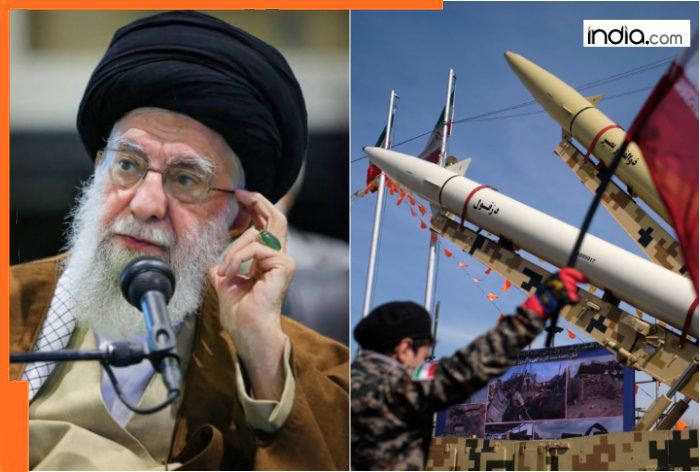Iran’s Islamic Revolutionary Guard Corps (IRGC) has revealed three major underground military bases, showcasing its preparedness for prolonged conflict. Iranian commanders claimed these sites are part of their readiness for any extended war scenario.
Footage broadcast on state television displayed hundreds of missiles stored inside heavily fortified bunkers, which Iran described as a ‘Missile Megacity.’ The bunkers housed multiple ballistic projectiles, with some positioned on mobile launchers for immediate deployment.
Missiles displayed in the Arsenal
Khorramshahr-4: A liquid-fuel rocket with a range of 2,000 km (1,242 miles), capable of carrying an advanced warhead weighing up to 2 tons (4,400 lbs).
Jahad: Another liquid-fuel rocket with a range of 1,000 km (621 miles), equipped with a 650 kg (1,400 lbs) warhead.
L360: A solid-fuel rocket capable of traveling 180 km (111 miles) while carrying a 150 kg (330 lbs) explosive payload.
Qadr: A two-stage rocket with a 2,000 km range and a payload capacity of up to 750 kg (1,650 lbs).
Emad: A liquid-fuel missile with a range of approximately 1,800 km (1,118 miles) and a warhead capacity of up to 750 kg.
Underground naval base
In addition to the missile megacity, the IRGC Navy showcased a hidden underground naval base located along Iran’s southern coast. The base contained:
Hundreds of missile-equipped speedboats
Anti-ship mines
A new cruise missile called the Qadr-380, capable of striking targets over 1,000 km away
The IRGC also announced the development of a new supersonic anti-ship cruise missile with a range exceeding 2,000 km, set to be unveiled soon.
These strategic revelations underline Iran’s efforts to bolster its defense capabilities amid rising tensions with Israel and the United States.
Iran expands military capabilities with new fighter jets, air defence systems, and naval power
Iran has intensified its military preparations by showcasing its latest fighter jets, air defense systems, and naval capabilities. Iran’s air force demonstrated a mix of domestically-produced aircraft like the Saeqeh and Azarakhsh, along with older American and Russian models dating back to before the 1979 Iranian Revolution.
During its military drills, Iran employed MiG-29 fighter jets and the recently acquired Yak-130, a subsonic two-seater jet provided by Russia in September 2023. The Yak-130 is primarily used to train pilots for advanced Su-35 fighter jets, which Iran had ordered but has yet to receive.
Iran showcased several advanced air defense systems, including an upgraded version of its domestic Bavar-373 system, designed to intercept missiles from over 300 km (186 miles) away. Equipped with Sayyad 4B surface-to-air missiles, this system is a key component of Iran’s high-altitude missile defense strategy.
Other air defense systems tested included the 15-Khordad, Majid, Arman, Zubin, and Tondar.
In January, Iran unveiled the 358 missile, a new surface-to-air missile with an estimated range of 400 km (248 miles). This addition aims to improve Iran’s ability to neutralize drones and low-altitude aerial threats.
Missile boat, drone Innovations
Iran’s IRGC unveiled the Haider-110, claimed to be the world’s fastest catamaran speedboat, capable of carrying two cruise missiles and reaching speeds of over 200 km/h (110 knots).
The newly launched Hadid-110 is a jet-powered suicide drone designed to be fired from an underwater drone before striking its target.
Submarine and torpedo arsenal
Iran displayed submarines such as Tareq, Fateh, and Ghadir. It also successfully tested domestically developed Valfajr torpedoes launched from submarines.
The IRGC announced plans to introduce a new hovercraft corvette equipped with missile systems, further strengthening Iran’s maritime defense capabilities.
